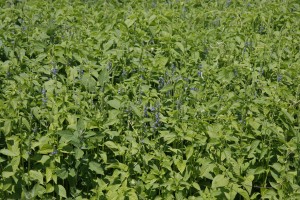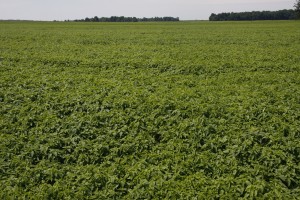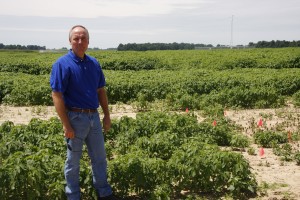A need for seed . . . Simpson County farmer pursuing markets for chia
Posted on Aug 29, 2013

Kummer , a former KFB Director and Simpson County FB President with a reputation as a forward thinker, is growing chia, (pronounced “chee-ah”), a species of flowering annual plant in the mint family grown commercially for its seed. The tiny seed is an excellent source of omega-3 fatty acids, soluble fiber and antioxidants. Chia seeds traditionally are consumed as a snack in Mexico and used as a food ingredient elsewhere. Chia is primarily grown in Argentina, Bolivia and Australia.
Kentucky Specialty Grains, a producer-owned company headed by Kummer, has obtained a licensing agreement from UK to pursue the commercialization of chia. The UK College of Agriculture is involved because it developed a patented variety of “long day length flowering lines of chia” capable of producing seed in Kentucky. Prior to that development, chia seed production was only feasible in tropical and subtropical latitudes due to the long growing season. The common chia is highly vulnerable to frost and wet ground.

UK issued a report last November stating “after several years of research and field trials, chia is emerging as a viable commercial crop for Kentucky growers.” The report added: “With the high demand for chia relative to supply, chia seed and seed products (such as oil) have a much higher value than canola, soy or flax.”
That’s what has Kummer enthused about the strange-looking crop he’s placed in a field surrounded by beans and corn. After beginning three years ago with three acres, he now has 110 acres and says “I wish I had a thousand.”
“I get e-mails everyday from people looking for seed,” he said from his office at the farm. “The demand currently is outpacing supply and the market is growing”

He went on to add, however, that his current enthusiasm stems from a crop that’s “doing great” through what has been a banner growing season in southern Kentucky. That wasn’t the case for the previous two years. He lost most of his first crop because much of it was planted on wet ground and didn’t make much a stand. Last year was a “so-so” crop, as chia is tolerant of drought, he said.
Kummer says “we’ve done this very quietly so far” due to the many uncertainties. Two factors have changed his position. (1) he has proved the crop can flourish in Kentucky, and (2) he recently received a USDA grant to conduct a market study. That work, he explained, probably will determine chia’s future on his farm.
“KSG received a value-added producer grant, which fits exactly what we’re trying to do with this,” he said. “We are looking to develop market demand from food processors who would use our seed as a food ingredient and then KSG would be able to expand production to more farmers.”
The UK report notes that “chia is a low-maintenance crop that prefers moderately fertile, well-drained soils. While moisture is necessary for seedling establishment, this crop is highly intolerant of wet soils. Seeds are planted into a fully tilled seed bed using a standard grain drill or planter with small seed metering capability. Because of small seed size precision planting is important to ensure good seed-to-soil contact. Chia is planted in April or May and harvested in October in Kentucky.”
As for the market outlook, the UK report said: “Chia is one of the highest sources of omega-3 fatty acids known. The health foods and nutraceutical industries are currently marketing raw chia seeds as a dietary supplement, as well as incorporating the seeds into snack foods, drink mixes and cerals; milled chia is sold as flour. This market is expected to grow.”
In three growing seasons Kummer has learned plenty. “It appears to be very drought-tolerant and works well on difficult ground. It’s an extremely delicate crop but it’s also tough, if that makes sense. It certainly can drown easily.”
Kummer said his target yield is 1,000 pounds per acre, which he feels is akin to a 150-bushel corn yield. Through last year’s horrific drought, he had a 700-pound yield in a field next to 34-bushel corn.
Although his chia field is low on weeds, control is a big challenge. So much so, in fact, that he has invested a substantial sum to develop herbicide test plots.
“Nearly every herbicide we’ve put on it kills it; we’re struggling to find the right herbicide and the right formula,” he said.
As for income, Kummer says $1 a pound is a reasonable target but that $1.50 is possible.
Kummer, who also has a reputation for wisely marketing his row crops (he formed Kentucky Specialty Grains several years ago as part of a project to produce food grade soybeans for customers in the Pacific Rim), said his extensive research indicates a current market demand for up to 25,000 tons, or roughly 100,000 acres. “Currently we’re only growing one-tenth of one-percent of that.”
Tagged Post Topics Include: Argentina, Australia, Bolivia, Chia seed, China, Chris Kummer, Health, Kentucky Specialty Grains, Mexico, Simpson County, UK College of Agriculture, USDA
Comments